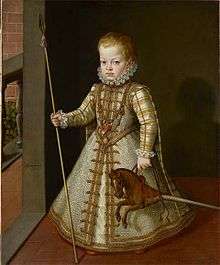Hobby horse (toy)
| Look up hobby horse in Wiktionary, the free dictionary. |

A hobby horse (or hobby-horse) is a child's toy horse, particularly popular during the days before cars. Children played at riding a wooden hobby horse made of a straight stick with a small horse's head (of wood or stuffed fabric), and perhaps reins, attached to one end. The bottom end of the stick sometimes had a small wheel or wheels attached. This toy was also sometimes known as a cock horse (as in the nursery rhyme Ride a cock horse to Banbury Cross) or stick horse.
Hobby horses feature in the worship of Rajasthani folk deity Baba Ramdevji, a reference to a story about his childhood; wooden toy horses are popular offerings at his temple at Ramdevra. They also figured in the public rites of the Romanian Călușari.[1]
 Woodcut illustration from Dryander, Der Arzney gemeiner Inhalt, 1542
Woodcut illustration from Dryander, Der Arzney gemeiner Inhalt, 1542 Detail from Children's games by Pieter Breugel the Elder, 1560
Detail from Children's games by Pieter Breugel the Elder, 1560 Portrait of the infant Don Diego by Coello, 1577
Portrait of the infant Don Diego by Coello, 1577 Child with a hobby horse
Child with a hobby horse Mexican papier-mâché hobby horses
Mexican papier-mâché hobby horses
Other meanings
A hobby horse is not always a riding-stick like the child's toy; larger hobby horses feature in some traditional seasonal customs (such as Mummers Plays and the Morris dance in England). They vary in size from a costume for one person to large frameworks carried by nine people.

From "hobby horse" (see Etymology, below) came the expression "to ride one's hobby-horse", meaning "to follow a favourite pastime", and in turn, the modern sense of the term hobby.[2]
The term is also connected to the draisine, a forerunner of the bicycle, invented by Baron Karl von Drais. In 1818, a London coach-maker named Denis Johnson began producing an improved version, which was popularly known as the "hobby-horse".[3]
The artistic movement, Dada, is possibly named after a French child's word for hobby-horse.[4]
Etymology
The word hobby is glossed by the OED as "a small or middle-sized horse; an ambling or pacing horse; a pony." The word is attested in English from the 14th century, as Middle English hobyn. Old French had hobin or haubby, whence Modern French aubin and Italian ubino. But the Old French term is apparently adopted from English rather than vice versa. OED connects it to "the by-name Hobin, Hobby", a variant of Robin" (compare the abbreviation Hob for Robert). This appears to have been a name customarily given to a cart-horse, as attested by White Kennett in his Parochial Antiquities (1695), who stated that "Our ploughmen to some one of their cart-horses generally give the name of Hobin, the very word which Phil. Comines uses, Hist. VI. vii." Another familiar form of the same Christian name, Dobbin has also become a generic name for a cart-horse.
Samuel Johnson, Dictionary of the English Language, 1755, glosses "A strong, active horse, of a middle size, said to have been originally from Ireland; an ambling nag."
Further use
Hoblers or Hovellers were men who kept a light nag that they may give instant information of threatened invasion. (Old French, hober, to move up and down; our hobby, q.v.) In mediæval times their duties were to reconnoitre, to carry intelligence, to harass stragglers, to act as spies, to intercept convoys, and to pursue fugitives. Henry Spelman (d. 1641) derived the word from "hobby".
Hobblers were another description of cavalry more lightly armed, and taken from the class of men rated at 15 pounds and upwards.— John Lingard, The History of England, (1819), vol. iv. chap. ii. p. 116.
The Border horses, called hobblers or hobbies, were small and active, and trained to cross the most difficult and boggy country, "and to get over where our footmen could scarce dare to follow." - George MacDonald Fraser, The Steel Bonnets, The Story of the Anglo-Scottish Border Reivers.
| Wikimedia Commons has media related to Toy hobby horses. |
Hobby Horse Polo uses parts of the polo rules but has its own specialities, as e.g. 'punitive sherries' and is using hobby horses instead of ponies. The Hobby Horse variant started 1998 as a fun sport in south western Germany and lead 2002 to the foundation of the First Kurfürstlich-Kurpfälzisch Polo-Club in Mannheim. In the meantime it gained further interest in other German cities.[5]
See also
References
- ↑ O. Buhociu, Le folklore roumain de printemps, 1957, p. 250
- ↑ "hobby," The Oxford English Dictionary. 2nd ed. 1989. OED Online. Oxford University Press. Retrieved 2010-06-26.
- ↑ David V. Herlihy, Bicycle, Yale University Press, 2004; pp. 31-38.
- ↑ Marc Dachy, Dada & les dadaïsmes, Paris, Gallimard, "Folio Essais", n° 257, 1994.
- ↑ Spiegel online, Hamburg, Germany (27 September 2014). "Steckenpferdpolo: Trendsportart in Dsseldorf im Rheinpark".